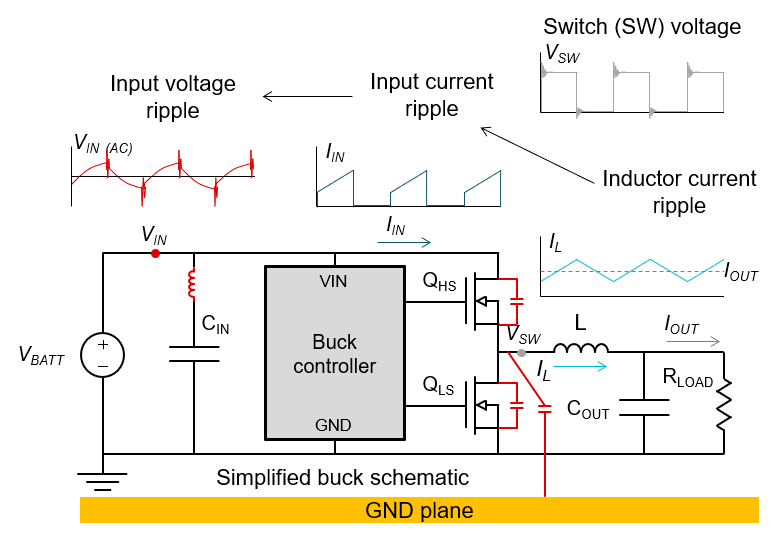SLUP408 February 2022 LM25149-Q1 , LM61460-Q1 , LM61495-Q1 , LMQ61460-Q1
- 1 Introduction
- 2 Defining EMI
- 3 What Causes EMI in a Switched-Mode DC/DC Regulator?
- 4 Existing Passive EMI Filtering Techniques
- 5 Passive Filter Limitations
- 6 AEF
- 7 Spread Spectrum
- 8 DRSS
- 9 True Slew-Rate Control
- 10HotRod™ Package Technology
- 11Optimized Package and Pinout
- 12Integrated Capacitors
- 13Conclusions
- 14References
- 15Important Notice
3 What Causes EMI in a Switched-Mode DC/DC Regulator?
In battery-powered systems (see Figure 3-1), a switched-mode power supply like a buck converter commutates a switch node between a low voltage (GND) and an input voltage. Filtering the switch-node voltage generates an average DC output voltage, which is between the input voltage and GND in the case of a buck converter. The switching causes input ripple at the fundamental switching frequency, and the square edges result in higher-frequency harmonics. Sharper edges with faster slew rates generate higher-frequency harmonic energy. The trapezoidal input current ripple is discontinuous and exhibits the same high-frequency components in the current ripple.
Parasitic capacitances and inductances are nonideal properties of components in the circuit. These parasitics interact negatively with the voltage and current and generate very-high-frequency spikes and ringing noise. On the other hand, jitter and dithering (spread spectrum) can create low-frequency oscillation and noise. Figure 3-2 shows common frequency ranges where noise occurs from these sources.
 Figure 3-1 Simplified buck controller
schematic and operating waveforms.
Figure 3-1 Simplified buck controller
schematic and operating waveforms. Figure 3-2 EMI frequency ranges for
spread spectrum and jitter, switching frequency and harmonics, and switch
ringing.
Figure 3-2 EMI frequency ranges for
spread spectrum and jitter, switching frequency and harmonics, and switch
ringing.This document discusses advanced power-converter features that improve upon existing methods to further reduce EMI. The five features entail the use of:
- An active EMI filter (AEF) to improve passive EMI filter performance.
- Dual-random spread spectrum (DRSS) to improve triangular and random spread spectrum.
- True slew-rate control to improve the series boot resistor technique.
- HotRod™ package technology to improve standard wire-bond connections.
- Integrated capacitors to improve external decoupling capacitor performance.